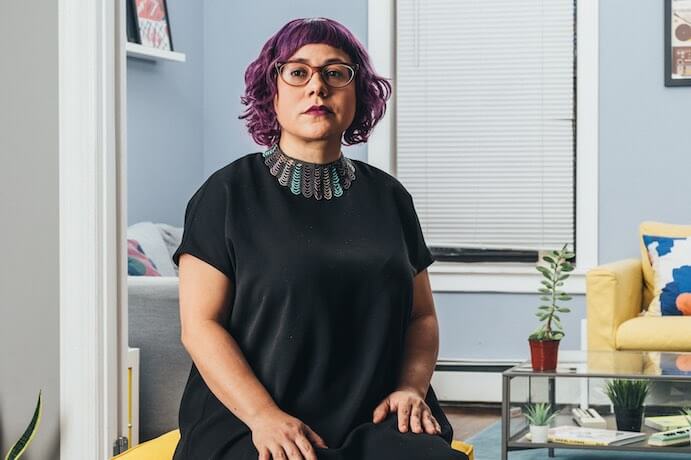This article was commissioned by American Composers Forum.
Angélica Negrón was born in Carolina, Puerto Rico, east of San Juan, on the northeast coast of the island. Currently she’s based in Brooklyn, New York, where she is busy working as a composer for ensembles, orchestras, and film scores, as well as a performer of her own music. She is a classically trained musician who has expanded into electronic music; she composes for a multiplicity of traditional instruments and a wide array of non-traditional sound-makers including robots and toys.
Her lush, layered, orchestral style that makes exquisite use of delicate, precise, unusual sounds as well as bold beats and gestures and everything in between, has developed idiosyncratically over time. Like many musicians, she wasn’t formally trained using the music of living composers. “I started composing in a kind of unorthodox way. Even though I was in music school for most of my life and I was a violinist and playing orchestras, I really didn’t explore sounds. I was just practicing my skills. When I started exploring sounds [as a young person], I had no idea that composing was a possibility. I had never played anything by someone that was living.”
What is so haunting about toy instruments like music boxes? Beyond a potential nostalgia factor for listeners who had them as children, both the miniature and the human-like automaton have fascinated humans since the 18th century. Encountering the invisible magic of a music box as a child–Where is the music coming from? How does this cylinder turn on its own after moving this crank a few times?–can stay with us during the rest of our lives, as we become adults and are encouraged to leave behind seemingly frivolous and “impractical” mysteries which can be explained by simple mechanics and physics.

Angélica Negrón speaks with joy–and tenderness–about small sounds. “I’m drawn to really tiny, miniscule sounds like music boxes, toy instruments. I collected music boxes for a long time. There’s this kind of thing that I find in toy instruments, the quirkiness to them. They are also never in tune! I love music that is in between the pitches. It sounds like it’s trying to be a straight up melody, but there’s something a little off. I think there’s also something about this kind of connection to childhood. In a way it is a way of unpacking moments of childhood that I was never able to fully understand. I think that that complexity of the sounds of toy instruments gets me closer to that.”
Tiny things hold our fascination, perhaps because scale is part of our vision, and key to our survival. As children, objects that are built for us allow us to create a world of our own, one of intimacy and privacy, at a time in our development when we have little control over the larger world and bigger people around us. Serendipity is a welcomed gift for experimenters, and most artists never lose their child-like wonder and ability to find pleasure in chance encounters which become generative over a lifetime of creation. Negrón finds intriguing sounds even in small, ordinary places. “[Exploring sounds with which to compose] was very much like me with a cassette player recording things from the environment. And I remember I had this really big calculator, and when you pushed the buttons they made very percussive clicking sounds, and I would record that. And then that would be my snare drum. I would pitch down things, and make my kick; I was very drawn to making and recording sounds and making electronic music with those, but I was also very new to composing and was more driven by curiosity.”
Negrón knows that she defies some expectations as a self-described “4’11” purple-haired Latina” in a sometimes male-dominated field, but she says that she’s unconcerned about people’s expectations of her music being “cute,” or whether they will find her signature incorporation of small sounds “feminine.” She knows her work transcends such binaries or categories, and is more concerned about expressing her visions as an individual and connecting with listeners. Many casual fans of electronic music, or the general audience for contemporary composers, might hold the stereotype of the single performer with a laptop on stage, maybe with some light show action, and perhaps some accompanying electric musicians with more laptops, maybe a keyboard or two. This wasn’t dynamic or personal enough for Negrón.
Live performance is important to Negrón, who learned early on that she wanted to engage the audience while she made music on stage. “One of the things that I realized when I started writing traditional instruments along with electronics was that if this was something that I was passionate about, I also needed to figure out a way to make it visually appealing and interesting. I wanted to find creative ways to approach the performance of electronic music. Because I felt that a lot of the music that I liked, when I saw a live performance, I was disappointed. I wanted to see the action behind the sound. And I wanted to feel invited into that room rather than be passive when someone is just on a laptop.”

Negrón talks about approaching her work intellectually, as well as about her passion for the physicality of sound creation. “It’s a path, but I would say it’s more of a commitment to problem solving. When I’m writing music I’m often thinking, How can I say something differently? How am I going to approach it in this piece? I also really like the mystery part of it. The audience might not know exactly how something is working or the technology that’s behind it, but it’s also very clear, and you can see that there’s a thing hitting another thing, and then it produces a sound, in the same way that you blow into a clarinet and then you hear a sound, or you put a bow on a string. It’s very visceral in the body; you can see the action and feel it. I wanted my electronics to also have that feeling.”
As a woman of color artist in a field where most of the resources are controlled by historically white institutions, Negrón has a hopeful vision beyond numerical inclusion. “I’m sure all of us artists of color have been ready for a long time for the conversation to get past the justifying why we deserve a seat at the table, or our name on the program, or the commission or all of that, right? Now a lot of the conversations are at a deeper level, when we’re lucky, and we get to have the conversation about how structurally we can also be involved so that the change really starts happening.”

The hustle is real, and so is exhaustion, for so many artists and workers in America. There’s a growing movement to take back time, joy, and healing from our privatized paradigms and our competitive, individualistic society. Negrón has a desire for working artists to build the conditions under which composers and musicians of color can thrive. “I hope we can have more and more spaces in which we can talk about the things that are important to us, that move beyond the needs of the administrators and the programmers and the commissioners.” There’s a hierarchy, and the money and access often flows downward, as in older systems of arts patronage. But there’s people power, too, and artists have always worked together, and struggled together, to try to be free, to live fully and on their own terms. In our increasingly interdependent global society, it’s clear to many that this work is collective. “That we can really talk about how we can as a community come together and create spaces so we can share conversations about survival strategies, so that ultimately we can get past that point of survival and go to joy.”
The world is fortunate to have artists like Angélica Negrón who continually expand what is possible in the arts, and thus the human experience. Negrón’s broad skill set with traditional and non-traditional instruments is evident, as is her curiosity and energy for experimentation. Graciously, her timeless wisdom transcends any particular technology. “I think at the core of it, people can perceive when an artist, regardless of the tools they’re using, or their idioms, are being authentic to who they are. And that is like a shortcut to the soul, right?”
I CARE IF YOU LISTEN is a program of the American Composers Forum, funded with generous donor and institutional support. A gift to ACF helps support the work of ICIYL. Editorial decisions are made at the sole discretion of the editor-in-chief. For more on ACF, visit the “At ACF” section or composersforum.org.
























